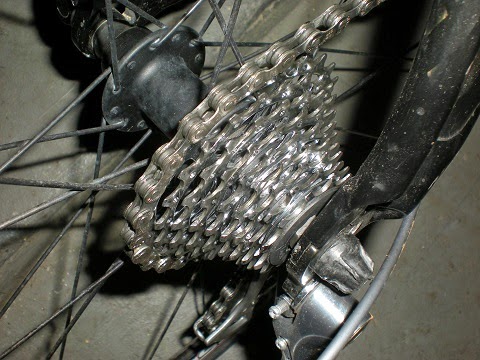Why change what seems to be a perfectly good chain?
The answer’s actually simple: chains wear out and even break. That wouldn’t be a problem except that “wearing out” means a chain gets longer. Here’s why:
 |
| The anatomy of a chain. |
So you should invest in a chain checker and check the chain for stretch regularly: monthly at least and weekly if you ride more than a couple of days a week.
 |
| A couple of different tools for checking whether a chain is ready to replace. |
 |
| A typical chain tool. |
Ready to start?
 |
| Routing through rear derailleur |
Either put the bike in a work stand or flip it upside down to get better access to the chain.
Step 2: Place one of the bottom links of the chain ("bottom" meaning the side that would normally be closer to the ground) in the rear notch of the chain tool (the farthest from the handle). Turn the chain tool handle until the pin contacts the chain, and make certain the pin is centered on one of the pins in the chain. Crank the handle clockwise (right) – hard. The pins are “peened” like rivets, and it takes some effort to shear off the little mushroom of steel. Once it snaps, keep turning the handle until it won’t turn any more. The pin should now be all the way out of the bearing (see the first picture).
Step 4: Take a few minutes to clean the cogset and chainwheel. Apply some degreaser and scrub off the accumulated crud with a bristle brush. Rinse everything with fresh water (don’t use a high-pressure spray) and repeat, if necessary. Clean the derailleur cage and the pulleys in the rear derailleur while you’re at it.
|
|
Thread the new chain through the frame and drive train, being careful to follow the same routing around the cogs, pulleys and chainwheels as the old chain. Install the connector link following the instructions that came with the new chain. Before you set the connector completely, spin the pedals a few times to make certain the chain is routed correctly. Once you're sure, tighten the connector link.
You’re done – in less than an hour, including the time to clean the drivetrain!
Goodies that will make this job a snap...
Note: You may need to fiddle with the adjustment of the rear derailleur after installing a new chain.
Note 2: Chains (should) come from the factory pre-lubricated, but you’ll want to monitor the new chain for a while.
All content including photos copyright © 2014-2018 by the author



No comments:
Post a Comment